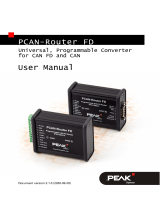Page is loading ...

Visualization and Recording of
Vehicle Data
User Manual
PCAN-MiniDisplay
Document version 1.2.2 (2015-08-19)

PCAN-MiniDisplay – User Manual
2
Products taken into account
Product name Model Firmware Part number
PCAN-MiniDisplay Display with three mounting
pegs
IPEH-002262
PCAN-MiniDisplay
Case
Display in casing with push
buttons
V1.1.x
IPEH-002262-KSM01
The front page shows the PCAN-MiniDisplay with three mounting pegs.
microSD™ is a trademark or registered tradema
rk of SD-3C, LLC in the United States
of America, other countries, or both.
All other product names mentioned in this document may be the trademarks or
registered trademarks of their respective companies. They are not explicitly marked
by “™” and “®”.
Copyright © 2015 PEAK-System Technik GmbH
Duplication (copying, printing, or other forms) and the electronic distribution of this
document is only allowed with explicit permission of PEAK-System Technik GmbH.
PEAK-System Technik GmbH reserves the right to change technical data without
prior announcement. The general business conditions and the regulations of the
license agreement apply. All rights are reserved.
PEAK-System Technik GmbH
Otto-Roehm-Strasse 69
64293 Darmstadt
Germany
Phone: +49 (0)6151 8173-20
Fax: +49 (0)6151 8173-29
www.peak-system.com
info@peak-system.com
Documen
t version 1.2.2 (2015-08-19)

PCAN-MiniDisplay – User Manual
3
Contents
1 Introduction 5
1.1 Properties at a Glance 5
1.2 Scope of Supply 6
2 Connectors 7
2.1 J1 External Buttons 7
2.2 J2 System 8
2.3 J3 USB 8
2.4 J4 JTAG 10
2.5 J5 microSD 10
2.6 J6 Serial 11
3 Scene Definition 12
3.1 General Description of an *.ins File 12
3.2 Example of an *.ins File 13
3.3 Using Several Scenes 15
4 Steps to Operation 16
4.1 Prerequisites 16
4.2 Preparing the Memory Card 16
4.3 Powering On the Device 18
4.4 Menus 19
4.5 Setting the Startup Options 20
5 CAN Tracing 22
5.1 Recording CAN Traffic 22
5.2 Playing Back Recorded CAN Traffic 23
5.3 Using the Recorded CAN Traffic on the PC 24
6 Filtering the CAN Traffic 27

PCAN-MiniDisplay – User Manual
4
7 Menu Reference for Settings and Maintenance 28
7.1 Device Settings 28
7.2 Internal Statistics 31
7.3 Memory Card 32
8 Technical Specifications 33
Appendix A CE Certificate 34
Appendix B Dimension Drawing 35
Appendix C Structure on the Memory Card 36
Appendix D Definition Files Reference 38
D.1 Scene Definition (*.ins) 38
D.2 Scenes Project File (*.inp) 56
D.3 CAN ID Filters (*.flt) 57
Appendix E Model with Casing 60
E.1 Scope of Supply 60
E.2 Push Buttons 61
E.3 Connectors 61
E.4 miniSD Card Slot 62

PCAN-MiniDisplay – User Manual
5
1 Introduction
The PCAN-MiniDisplay is used as human-machine interface for the
visualization of CAN data. For the connection to the CAN bus, it has
a High-speed and a Single-wire CAN connector. The graphic repre-
sentation of incoming CAN data is configured before using the unit
and then is performed on a TFT display.
Besides the display of CAN data, the PCAN-MiniDisplay can also be
used for data logging. The data traffic is recorded to a memory card
and can be played back onto the CAN bus as well as analyzed on a
PC later on.
In addition to the PCAN-MiniDisplay board to be used for mounting,
there is a version in plastic casing with push buttons available. This
can be used to create and evaluate application-specific configura-
tions. Furthermore, the user can switch between different configura-
tions during operation.
This user manual refers to the PCAN-MiniDisplay board to be used
for mounting. The specific features of the model with casing (IPEH-
002262-KSM01) are described in Appendix E on page 60.
Note: This manual refers to devices that are operated with
firmware version 1.1.x.
1.1 Properties at a Glance
CAN connections via a High-speed CAN channel (ISO 11898-2)
and a Single-wire CAN channel (SAE J2411)
TFT display with 320 x 240 pixel resolution
Slot for microSD memory card (max. 32 GByte), 512 MByte card
enclosed

PCAN-MiniDisplay – User Manual
6
High-speed USB 2.0 port for access to the memory card using a PC
Freely configurable visualization of CAN data via text files
Run configurations from the memory card
Switch between multiple display configurations via push
buttons (optional)
Optional autostart of a configuration using a default name
Recording of incoming CAN messages to the memory card
Conversion of trace data to various output formats using
Windows software
Playback of trace files
Filtering of CAN IDs per CAN channel
Wake-up via CAN
Dimensions: 70 x 50 mm
Supply voltage from 7 to 30 V DC
Operating temperature range from -20 to 70 °C (-4 to 158 °F)
1.2 Scope of Supply
PCAN-MiniDisplay
Connection cable assembly (50 cm length) with open wire ends
for peripherals (power supply, field busses, digital inputs)
microSD memory card (512 MByte)
This user manual in PDF format
The specific features of the model with casing and buttons
(IPEH-002262-KSM01) are described in Appendix E on page 60.

PCAN-MiniDisplay – User Manual
7
2 Connectors
The connectors on the circuit board are:
J1 External Buttons (2.1 below)
J2 System (2.2 on page 8)
J3 USB (2.3 on page 8)
J4 JTAG (2.4 on page 10)
J5 microSD (2.5 on page 10)
J6 Serial (2.6 on page 11)
For basic use, at least the power supply (J2), a CAN connection (J2),
and a microSD memory card (J5) are needed.
2.1 J1 External Buttons
3 push buttons can be connected and used to navigate through the
menus of the PCAN-MiniDisplay user interface. This is for mainte-
nance and debugging purposes. For example a user of the PCAN-
MiniDisplay can be enabled to do communication configuration
changes or CAN tracing.
Pin assignment External Buttons
Pin Function
1 Din1: Down
2 Din2: Up
3 Din3: Enter
4 GND
The 3 push buttons connect each function pin (1 to 3) to GND.

PCAN-MiniDisplay – User Manual
8
2.2 J2 System
Power supply
1 High-speed CAN channel (CAN1), 1 Single-wire CAN channel
(CAN2), alternative use of an external transceiver with CAN2
1 digital output, 1 digital input, 2 analog inputs
Pin assignment System
Pin Function
1 Vb (7 - 30 V DC)
2 GND
3 Dout1
4 Din4
5 Ain1
6 Ain2
7 not connected or CAN2-RxD
1
8 CAN2_SW or CAN2-TxD
1
9 CAN1_L
10 CAN1_H
2.3 J3 USB
Access the memory card in the PCAN-MiniDisplay from a PC via
USB connection. The memory card can also be accessed if the
PCAN-MiniDisplay is switched off. At startup of the device, the USB
connection is briefly interrupted.
1
TTL signal for optional external CAN transceiver

PCAN-MiniDisplay – User Manual
9
Pin assignment USB
Pin Function
1 5 V USB
2 D-
3 D+
4 GND
5 GND
2.3.1 Unplugging the USB Connection
Before unplugging the USB cable from the PC or the PCAN-
MiniDisplay, the device should be logged out of the operating
system. This procedure ensures that the operating system has
correctly finished a write process to the memory card of the PCAN-
MiniDisplay.
Windows: Safely remove hardware icon in the taskbar notification area
2.3.2 Restriction for PCAN-MiniDisplay Functions
During a USB connection to a PC some functions of the PCAN-
MiniDisplay are limited, because the device cannot access the
memory card at the same time as the connected PC:
Scene definitions (instruments) cannot be loaded.
The recording and playback of CAN traffic (trace) do not work.
The commands in the Memory Card menu do not work.

PCAN-MiniDisplay – User Manual
10
2.4 J4 JTAG
Access the microcontroller for debugging purposes.
Pin assignment JTAG
Pin Function
1 GND
2 GND
3 Reset#
4 3.3 V
5 TCK
6 TMS
7 TDO
8 TDI
9 RTCK
10 TRST
2.5 J5 microSD
Slot for a microSD memory card (max. 32 GByte).
Location of the microSD card slot
on the circuit board of the PCAN-MiniDisplay (bottom view)

PCAN-MiniDisplay – User Manual
11
2.6 J6 Serial
Provides serial signals for customer-specific extensions.
Pin assignment Serial
Pin Function
1 GND
2 5 V
3 TxD RS-232
4 RxD RS-232
5 SCL (Software I²C)
6 SDA (Software I²C)

PCAN-MiniDisplay – User Manual
12
3 Scene Definition
The PCAN-MiniDisplay uses a so called scene for display of CAN
data in graphical form.
3.1 General Description of an *.ins File
A scene is a collection of instruments, labels, fonts, etc. defined in a
text file with the *.ins extension. Scenes furthermore include
bitmap graphic files (*.bmp) and font files (*.fon).
The content of a scene definition file is divided in different sections
each containing definition entries:
[global]: common definitions for the scene
[instrumentX]: used bitmaps
[labelX]: text-based labels
[variableX]: CAN variables that are used by labels, the plotter,
and instruments
[fontX]: fonts that are used by labels
[plotterX]: line writer diagram
A reference to the keywords to be used in those sections is located
in appendix section D.1 on page 38. An example file is shown
below.
A definition
file can contain comments that are lead in by double
slashes (//). All characters in the line after a double slash are ignored
as the *.ins file is interpreted by the PCAN-MiniDisplay.
During load time, the PCAN-MiniDisplay generates a binary version
of a definition (*.inb). That one is loaded much faster on future

PCAN-MiniDisplay – User Manual
13
use, because all conversions for panel-internal use are already
incorporated. This is the default behavior, but can be configured in
the Global section.
Altering the definition of a scene can only be done in the text-based
file.
Note: If the definition of a scene is altered, the previously
generated binary file (*.inb) must be manually deleted on the
memory card of the PCAN-MiniDisplay, so the loader sees that
a new binary must be created from the text file. If you do not
delete the binary file, your changes in the definition file will not
have any effect.
3.2 Example of an *.ins File
Note: The text file (*.ins) must have an empty line at its end.
[global]
format=1
instruments=2
variables=1
labels=1
flashing_time=300
compress=0
[instrument1]
pictures=1
name="Background"
no_restore=1
0="Background_320_240.bmp","",0,0,0,0
[instrument2]
pictures=2
name="turn_left"
no_restore=0
offset=0,0
var_name="clig"
0="empty_28_20.bmp","",0,0,0,0
1="turn_l_28_20.bmp","",0,0,1,1

PCAN-MiniDisplay – User Manual
14
[variable1]
name="oiltemperature"
canid=779 // ID in decimal notation
position=8,8
frametype=0
byteorder=0
scale=0.62745
offset=-10
vartype=0
datatype=1
[label1]
name="Oil Temperature"
position=0,106
font_idx=3 // lucida_13_18
length=5
fmt_string="% 4d°" // Special treatment for degree character
// "°" (ASCII 127)
initval="----°"
fontcolor=200,200,0 // green
bgcolor=0,0,0 // black
sector=1
range=-10,124
fontcolor=200,200,0
bgcolor=0,0,0
flashing=0
sector=1
range=125,150
fontcolor=255,0,0
offcolor=127,0,0
bgcolor=0,0,0
flashing=1

PCAN-MiniDisplay – User Manual
15
3.3 Using Several Scenes
It is possible to use more than one scene on the PCAN-MiniDisplay.
Scenes can be switched by using the digital inputs (e.g. with push
buttons).
To achieve this, a list of scene definition files must be created in a
scenes project file (*.inp). This list also defines which scene is
used on startup.
A reference to the keywords to be used in those sections is located
in appendix section D.2 on page 56. An example file is shown
below.
Note: The text file (*.inp) must have an empty line at its end.
[general]
version=1
[scenes]
scenes=4
startscene=2
1="speedo0.ins"
2="speedo1.ins"
3="picture1.ins"
4="picture2.ins"

PCAN-MiniDisplay – User Manual
16
4 Steps to Operation
On power-on the PCAN-MiniDisplay looks for the internally saved
startup options. A scene for display or the tracer for CAN recording
can be started automatically.
Tip: At delivery, the PCAN-MiniDisplay is configured to start a
scene called Default.inp. Therefore, the device can be
deployed without the need of initial user interaction via push
buttons.
This chapter describes the steps to put the PCAN-MiniDisplay to
operation. Please go through each of the following sections.
4.1 Prerequisites
microSD memory card, max. 32 GByte
(512 MByte card is enclosed)
PC with SD card reader (including adapter for microSD card)
or
USB connection PC to PCAN-MiniDisplay (connected to J3)
Power supply 7 to 30 V DC (connected to J2)
4.2 Preparing the Memory Card
So that the device starts up properly, the memory card must contain
a specific directory structure. This is present on delivery. You can
add your own scenes to the directory structure.

PCAN-MiniDisplay – User Manual
17
Do the following to prepare the memory card with your scenes:
1. Establish a USB connection between the PCAN-MiniDisplay
and a PC in order to access the microSD memory card from
the PC.
As an alternative, remove the card from the PCAN-
MiniDisplay and insert it into a slot of a card reader attached
to a PC.
The memory card appears as a separate mass storage
device in your PC’s operating system.
2. Copy one or several scenes that you have created previous-
ly (see 3
Scene Definition
on page 12) into the following
directory of the memory card: /MiniDisplay/Scenes/
Each scene must have its own subdirectory.
At delivery, the PCAN-MiniDisplay is configured to auto-
matically show the following scene at power-on:
/MiniDisplay/Scenes/Default/Default.inp
3. Sign off the USB connection in the PC’s operating system
and disconnect the USB cable.
If prepared in a PC, remove the microSD memory card from
it and insert it into the slot of the PCAN-MiniDisplay.
If needed (e.g. on implementing a new card or if the directory
structure is messed up), do the following to restore the directory
structure on the card:
1. Establish a USB connection between the PCAN-MiniDisplay
and a PC in order to access the microSD memory card from
the PC.
As an alternative, remove the card from the PCAN-
MiniDisplay and insert it into a slot of a card reader attached
to a PC.
The memory card appears as a separate mass storage
device in your PC’s operating system.

PCAN-MiniDisplay – User Manual
18
2. With the operating system, format the memory card with
the FAT32 file system.
3. From the provided DVD, copy the MiniDisplay directory
including all subdirectories and files to the root directory of
the memory card. On the DVD, the MiniDisplay directory
is located under the following directory:
/Tools/PCAN-MiniDisplay/
For supplementary information, see Appendix C
Structure
on the Memory Card
on page 36.
4. Sign off the USB connection in the PC’s operating system
and disconnect the USB cable.
If prepared in a PC, remove the microSD memory card from
it and insert it into the slot of the PCAN-MiniDisplay.
4.3 Powering On the Device
The PCAN-MiniDisplay is powered on by applying a supply voltage
in the range of 7 to 30 V DC to connector J2. The device starts up
automatically. If not altered after delivery, the PCAN-MiniDisplay
shows the scene with the name Default.inp.
If the supply voltage has been applied before and the device is off
by using the corresponding menu entry, it can be started again by
activating the Down input on connector J1.
For details about the connectors see chapter 2 on page 7.

PCAN-MiniDisplay – User Manual
19
4.4 Menus
The PCAN-MiniDisplay provides a user interface with menus in
order to change the setup of functions. The navigation is done via
the digital inputs of connector J1 that can be equipped with push
buttons, for example. See section 2.1 on page 7 for details about the
conn
ection.
Tip: The PCAN-MiniDisplay Case has the mentioned buttons
built in. See Appendix E on page 60 for more information about
this model.
Browsing through the menus and functions is done with the Up
and Down buttons, a selected item is activated with the Enter
button.
While displaying a scene, pressing the Enter button brings you
back to the main menu.
Tip: The use of the menus is not needed for pure display of a
scene, because basic settings can be defined in the definition
file Default.inp which is automatically loaded with delivery
settings. Thus, buttons can be omitted in that case.

PCAN-MiniDisplay – User Manual
20
4.4.1 Status Indication
While using the menus, icons on the upper right of the screen
indicate the status of the CAN bus communication for the CAN
channels 1 (High-speed CAN) and 2 (Single-wire CAN).
Icon Meaning
T R
CAN traffic: T = Transmit, R = Receive
Blinking: Outgoing/incoming CAN messages
Green: Regular traffic
Yellow, red: Faulty traffic
act
pas
off
Informs about the CAN controller status (active, passive, bus off). When
entering bus-off state, due to high (transmission) error rate, no further
CAN messages are transmitted or received. In this case, after fixing the
bus problem (e.g. a wrong CAN bitrate), a power cycle (off and on)
must be performed to reset the CAN controller.
L
The CAN channel operates in listen-only mode. This is enabled in the
device settings (see section 7.1.3 on page 29).
4.5 Setting the Startup Options
The main menu entry Startup Options offers the possibility to
set up the behavior on power-on.
Do the following to display a scene at startup:
Note: At delivery, the PCAN-MiniDisplay is configured to start a
scene called Default.inp.
1. Click Show Scene.
2. From the displayed directory structure, select a scene
(*.ins) or a project (*.inp) that is to be shown at startup.
In the Startup menu, the selected file is indicated in the
bottom status line.
/





